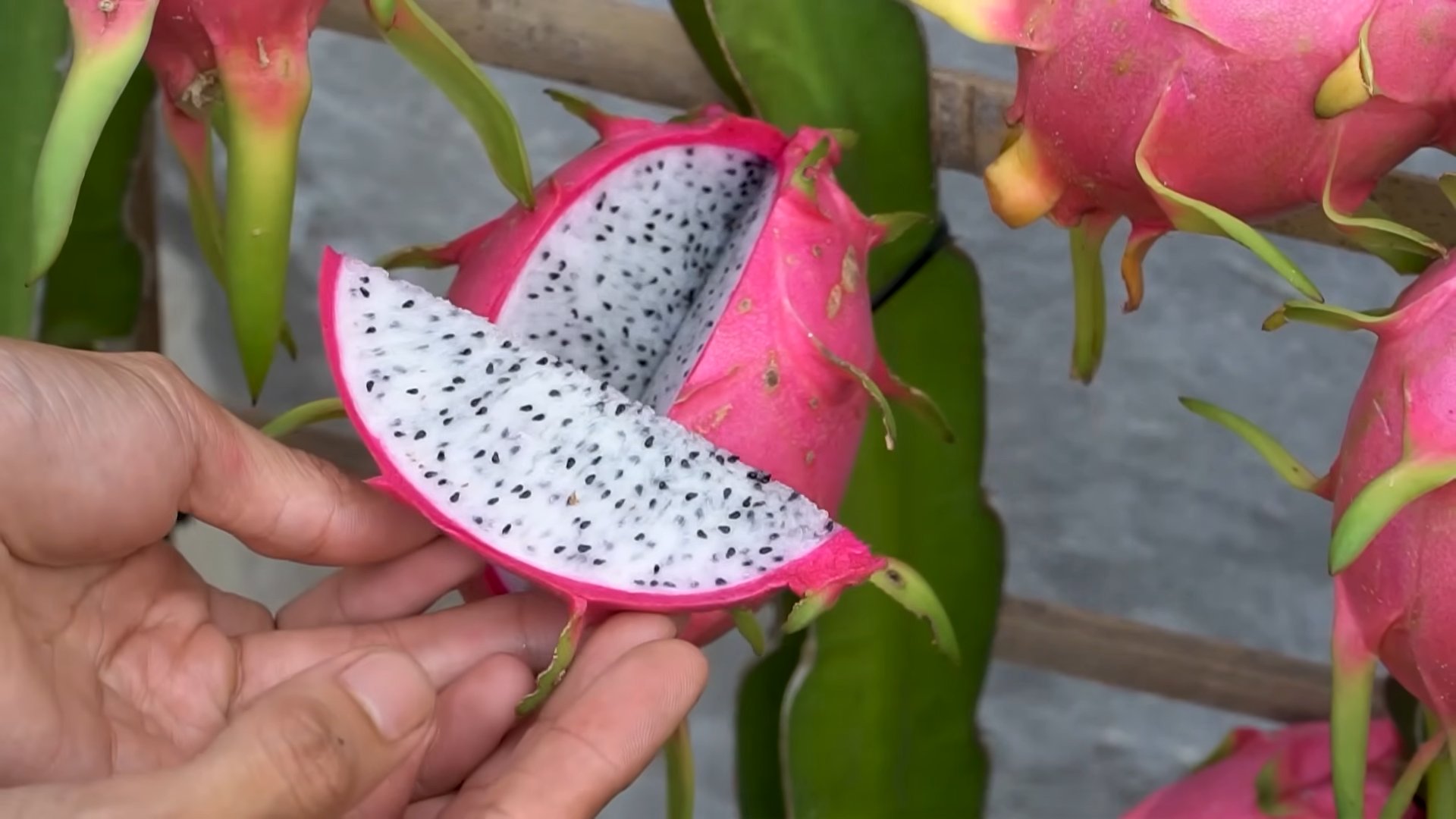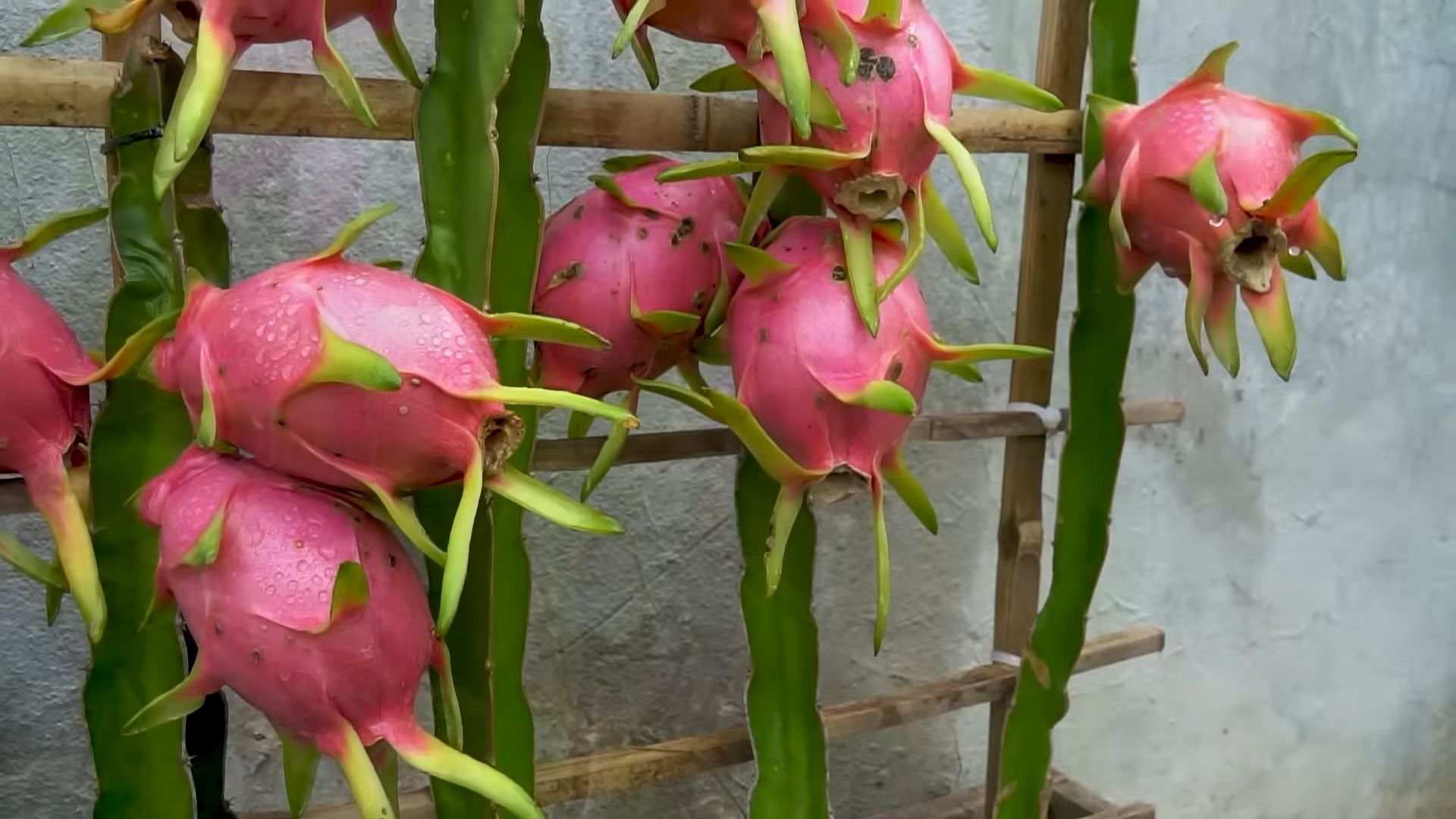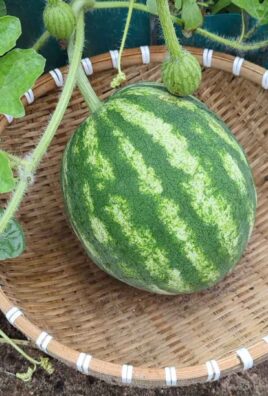Growing Dragon Fruit at Home might seem like an exotic dream reserved for tropical climates, but I’m here to tell you it’s more achievable than you think! Forget those expensive supermarket prices and imagine plucking your own vibrant, sweet dragon fruit straight from your backyard.
For centuries, dragon fruit, also known as pitaya, has been cultivated in Southeast Asia and Latin America, revered not only for its delicious taste but also for its striking beauty. Its vibrant colors and unique shape have made it a symbol of prosperity and good fortune in many cultures. But you don’t need to travel to the tropics to experience this amazing fruit.
In this DIY guide, I’ll share my top secrets and simple tricks for successfully growing dragon fruit at home, no matter where you live. Whether you have a sprawling garden or just a sunny balcony, I’ll show you how to create the perfect environment for these fascinating plants to thrive. From choosing the right variety to providing the necessary support and care, I’ll cover everything you need to know.
Why bother with this DIY project? Because nothing beats the satisfaction of nurturing a plant from a small cutting to a fruit-bearing beauty. Plus, you’ll have access to fresh, organic dragon fruit whenever you crave it. So, are you ready to embark on this exciting gardening adventure with me? Let’s get started!

Growing Dragon Fruit at Home: A Beginner’s Guide
Hey there, fellow plant enthusiasts! Ever dreamt of harvesting your own exotic dragon fruit? It’s totally achievable, even if you don’t live in a tropical paradise. I’m going to walk you through everything you need to know to successfully grow dragon fruit at home, from choosing the right variety to harvesting your delicious bounty. Let’s get started!
Choosing Your Dragon Fruit Variety
Before we dive into the nitty-gritty, let’s talk varieties. Dragon fruit comes in several types, each with its own unique flavor and appearance. Here’s a quick rundown:
* White-fleshed varieties (e.g., ‘Hylocereus undatus’): These are the most common and often the easiest to find. They have a mild, slightly sweet flavor.
* Red-fleshed varieties (e.g., ‘Hylocereus costaricensis’): These are known for their vibrant color and slightly tart taste. They’re also packed with antioxidants!
* Pink-fleshed varieties (e.g., ‘Hylocereus guatemalensis’): These offer a flavor profile somewhere between the white and red varieties.
* Yellow-skinned varieties (e.g., ‘Selenicereus megalanthus’): These are considered the sweetest and most flavorful, but they can be a bit more challenging to grow.
My recommendation? Start with a white-fleshed or red-fleshed variety. They’re generally more forgiving and readily available. Once you’ve mastered the basics, you can branch out and try the more exotic types.
Getting Started: Propagation Options
You have two main options for starting your dragon fruit journey: seeds or cuttings.
* Seeds: Growing from seed is possible, but it’s a slower process, and the resulting plant may not be true to the parent variety. Plus, it can take several years to get fruit.
* Cuttings: This is the method I highly recommend. Cuttings are faster, easier, and guarantee you’ll get the same variety as the parent plant.
We’ll focus on using cuttings for this guide.
Preparing Your Cutting
1. Source a Healthy Cutting: Find a reputable source for your cutting. Look for a healthy, mature stem that’s at least 12 inches long. Avoid cuttings that are damaged, discolored, or show signs of disease.
2. Let the Cutting Callous: This is crucial! Place the cutting in a dry, shaded area for about 7-10 days. This allows the cut end to callous over, preventing rot when you plant it. You’ll notice a hardened layer forming over the cut surface.
3. Prepare Your Potting Mix: Dragon fruit needs well-draining soil. A mix of cactus potting mix, perlite, and a bit of compost works wonders. I usually go for a 1:1:1 ratio.
4. Choose the Right Pot: Select a pot that’s at least 10-12 inches in diameter. Dragon fruit will eventually need a larger pot, but this is a good starting size. Make sure the pot has drainage holes!
Planting Your Dragon Fruit Cutting
1. Fill the Pot: Fill your pot with the prepared potting mix, leaving a couple of inches of space at the top.
2. Plant the Cutting: Insert the calloused end of the cutting into the soil, burying it about 2-3 inches deep.
3. Water Gently: Water the soil lightly, just enough to moisten it. Avoid overwatering, as this can lead to root rot.
4. Provide Support: Dragon fruit is a climbing cactus, so it needs support. You can use a sturdy stake, a trellis, or even a section of PVC pipe. Place the support near the cutting and gently tie the cutting to it.
5. Find the Right Location: Place the pot in a sunny location that receives at least 6-8 hours of direct sunlight per day. Dragon fruit loves the sun!
Caring for Your Dragon Fruit Plant
1. Watering: Water your dragon fruit plant when the top inch of soil feels dry to the touch. During the growing season (spring and summer), you may need to water more frequently. In the winter, reduce watering. Remember, dragon fruit is a cactus, so it’s more tolerant of underwatering than overwatering.
2. Fertilizing: Feed your dragon fruit plant with a balanced fertilizer (e.g., 10-10-10) every 2-3 months during the growing season. You can also use a fertilizer specifically formulated for cacti and succulents.
3. Pruning: Pruning is essential for shaping your dragon fruit plant and encouraging fruit production. Remove any dead or damaged stems. You can also prune to control the size and shape of the plant. The goal is to encourage branching and create a strong, healthy structure.
4. Pest and Disease Control: Dragon fruit is generally pest-resistant, but keep an eye out for common pests like aphids, mealybugs, and scale. If you spot any pests, treat them with insecticidal soap or neem oil. Root rot is the most common disease, so avoid overwatering.
5. Provide Adequate Support: As your dragon fruit plant grows, it will need increasingly sturdy support. A strong trellis or post is essential to prevent the plant from collapsing under its own weight. I’ve seen people use old tires stacked on top of each other as a support structure, which is a pretty creative and effective solution!
Encouraging Flowering and Fruiting
1. Sunlight: Dragon fruit needs plenty of sunlight to flower and fruit. Make sure your plant is getting at least 6-8 hours of direct sunlight per day.
2. Temperature: Dragon fruit thrives in warm temperatures (70-80°F). It can tolerate temperatures as low as 40°F, but it’s best to protect it from frost.
3. Pollination: Most dragon fruit varieties are self-pollinating, but cross-pollination can increase fruit size and yield. If you have multiple dragon fruit plants, you can hand-pollinate them by transferring pollen from one flower to another using a small brush. This is best done at night, as dragon fruit flowers bloom at night.
4. Watering During Flowering: Maintain consistent watering during the flowering period. Avoid letting the soil dry out completely.
5. Fertilizing During Flowering: Switch to a fertilizer with a higher phosphorus content (the middle number in the N-P-K ratio) to encourage flowering and fruit development.
Harvesting Your Dragon Fruit
1. Timing: Dragon fruit typically takes about 30-50 days to ripen after flowering.
2. Appearance: The fruit is ripe when the skin turns a bright, even color (depending on the variety) and the “wings” or scales on the fruit start to dry out and turn brown.
3. Texture: The fruit should feel slightly soft to the touch, but not mushy.
4. Harvesting: Use a sharp knife or pruning shears to cut the fruit from the stem. Be careful not to damage the plant.
5. Enjoy! Once harvested, dragon fruit can be stored in the refrigerator for up to a week. Enjoy it fresh, in smoothies, or in desserts.
Troubleshooting
* Yellowing Leaves: This could be a sign of overwatering, underwatering, or nutrient deficiency. Check the soil moisture and adjust your watering accordingly. Fertilize with a balanced fertilizer.
* Lack of Flowering: This could be due to insufficient sunlight, improper fertilization, or lack of maturity. Make sure your plant is getting enough sunlight and fertilize with a fertilizer high in phosphorus. It may also take a few years for your plant to mature enough to flower.
* Root Rot: This is usually caused by overwatering. Make sure your soil is well-draining and avoid letting the plant sit in standing water. If you suspect root rot, repot the plant in fresh soil and trim away any rotted roots.
* Pests: Inspect your plant regularly for pests and treat them promptly with insecticidal soap or neem oil.
Overwintering Dragon Fruit
If you live in an area with cold winters, you’ll need to protect your dragon fruit plant from frost.
* Bring it Indoors: If your plant is in a pot, you can bring it indoors to a sunny location.
* Provide Supplemental Light: If your plant isn’t getting enough sunlight indoors, you may need to provide supplemental light with a grow light.
* Reduce Watering: Reduce watering during the winter months, as the plant will be dormant.
* Protect from Frost: If you can’t bring your plant indoors, you can protect it from frost by covering it with a blanket or burlap sack.
Final Thoughts
Growing dragon fruit at home is a rewarding experience. It

Conclusion
So, there you have it! Growing dragon fruit at home, while it might seem like an exotic endeavor, is surprisingly achievable and incredibly rewarding. We’ve walked you through the essential steps, from selecting the right cutting or seedling to providing the optimal growing conditions and patiently waiting for those vibrant fruits to appear.
Why is this DIY trick a must-try? Because it offers a unique opportunity to connect with nature, cultivate your own delicious and nutritious fruit, and impress your friends and family with your gardening prowess. Imagine the satisfaction of harvesting your own dragon fruit, knowing you nurtured it from a small cutting to a thriving plant. The taste of homegrown dragon fruit, bursting with freshness and subtly sweet flavor, is simply unmatched by anything you can find in a store. Plus, you’ll be avoiding the pesticides and long-distance transportation often associated with commercially grown fruit.
But the benefits extend beyond just the taste. Growing dragon fruit is a fantastic way to add a touch of the tropics to your garden or patio. The plant itself is visually stunning, with its unique climbing habit and large, fragrant flowers that bloom at night. It’s a conversation starter, a beautiful addition to your landscape, and a source of endless fascination.
Don’t be afraid to experiment with variations! Try different varieties of dragon fruit to discover your favorite flavor profile. Some varieties are sweeter, some are tangier, and some have different colored flesh. You can also experiment with different trellising methods to find what works best for your space and aesthetic preferences. Consider adding companion plants around your dragon fruit to attract pollinators and improve soil health.
Ready to embark on your dragon fruit growing adventure? We wholeheartedly encourage you to give it a try. It’s a project that requires patience and attention, but the rewards are well worth the effort. Start small, learn as you go, and don’t be discouraged by setbacks. Every gardener faces challenges, and overcoming them is part of the fun.
And most importantly, share your experience! We want to hear about your successes, your challenges, and your tips for growing dragon fruit at home. Post photos of your plants, share your harvesting stories, and let us know what you’ve learned along the way. Together, we can create a community of dragon fruit enthusiasts and help each other grow the best possible fruit. So, grab a cutting, prepare your soil, and get ready to experience the joy of growing your own dragon fruit. You won’t regret it! This is truly the best way to get fresh, delicious, and organic dragon fruit.
Frequently Asked Questions (FAQ)
1. What is the best time of year to plant dragon fruit?
The best time to plant dragon fruit is during the spring or early summer. This allows the plant to establish itself and grow during the warmer months, giving it a strong foundation before the cooler seasons arrive. In regions with mild winters, you can potentially plant dragon fruit year-round, but spring and early summer are generally the most favorable. Avoid planting during periods of extreme heat or cold.
2. How much sunlight does dragon fruit need?
Dragon fruit thrives in full sun, requiring at least 6-8 hours of direct sunlight per day. Adequate sunlight is crucial for healthy growth, flowering, and fruit production. If you live in a region with intense summer heat, providing some afternoon shade can prevent sunburn on the plant. However, ensure that the plant still receives ample sunlight throughout the day. Insufficient sunlight can lead to weak growth, reduced flowering, and smaller, less flavorful fruit.
3. What kind of soil is best for dragon fruit?
Dragon fruit prefers well-draining soil that is slightly acidic to neutral (pH 6.0-7.0). The soil should be rich in organic matter and have good aeration to prevent root rot. A mixture of sandy loam, compost, and perlite or vermiculite is ideal. Avoid heavy clay soils that retain too much water. If your soil is heavy, amend it with organic matter and drainage materials to improve its structure and drainage. Regular soil testing can help you determine the pH and nutrient levels and make necessary adjustments.
4. How often should I water my dragon fruit plant?
Water dragon fruit regularly, especially during the growing season (spring and summer). Water deeply when the top inch or two of soil feels dry to the touch. Avoid overwatering, as this can lead to root rot. Reduce watering during the dormant season (fall and winter). The frequency of watering will depend on the climate, soil type, and size of the plant. Monitor the soil moisture regularly and adjust your watering schedule accordingly.
5. What kind of fertilizer should I use for dragon fruit?
Dragon fruit benefits from regular fertilization, especially during the growing season. Use a balanced fertilizer with a ratio of 10-10-10 or 15-15-15. Apply fertilizer every 2-3 months during the spring and summer. You can also supplement with organic fertilizers such as compost tea or worm castings. Avoid over-fertilizing, as this can damage the plant. Follow the instructions on the fertilizer label carefully. During the dormant season, reduce or eliminate fertilization.
6. How long does it take for dragon fruit to produce fruit?
Dragon fruit typically takes 6-18 months to produce fruit from a cutting, and 2-5 years from seed. The time to fruiting depends on several factors, including the variety of dragon fruit, the growing conditions, and the age and health of the plant. Providing optimal growing conditions, such as ample sunlight, well-draining soil, and regular fertilization, can help speed up the fruiting process. Be patient and consistent with your care, and you will eventually be rewarded with delicious dragon fruit.
7. How do I know when my dragon fruit is ripe?
Dragon fruit is ripe when the skin turns from bright green to a vibrant red, pink, or yellow, depending on the variety. The fruit should also feel slightly soft to the touch, similar to a ripe avocado. The “wings” or scales on the fruit will begin to dry out and may start to curl back. Gently twist the fruit; if it comes off the stem easily, it is ripe. Avoid picking the fruit too early, as it will not ripen further off the vine.
8. What are some common pests and diseases that affect dragon fruit?
Dragon fruit can be susceptible to pests such as aphids, mealybugs, and scale insects. These pests can be controlled with insecticidal soap or neem oil. Root rot is a common disease that can affect dragon fruit, especially in poorly draining soil. Prevent root rot by ensuring that the soil is well-draining and avoiding overwatering. Other potential diseases include fungal infections, which can be treated with fungicides. Regularly inspect your plants for signs of pests or diseases and take action promptly to prevent them from spreading.
9. How do I prune my dragon fruit plant?
Pruning is essential for maintaining the shape and health of your dragon fruit plant. Prune regularly to remove dead, damaged, or overcrowded branches. This will improve air circulation and sunlight penetration, which can help prevent diseases and promote fruit production. You can also prune to control the size and shape of the plant. Prune after the fruiting season or during the dormant season. Use clean, sharp pruning shears to avoid spreading diseases.
10. Can I grow dragon fruit in a container?
Yes, dragon fruit can be successfully grown in containers, making it a great option for those with limited space. Choose a large container with good drainage holes. Use a well-draining potting mix and provide a sturdy trellis or support structure for the plant to climb on. Container-grown dragon fruit may require more frequent watering and fertilization than plants grown in the ground. Place the container in a sunny location and protect it from extreme temperatures.





Leave a Comment